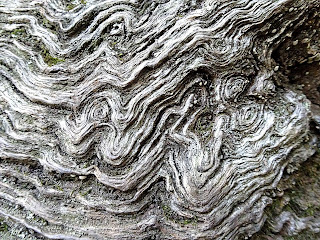The
Blue Ridge Parkway isn’t only about grand views and high elevations; it is also
about art & culture (for example the Folk Art Center), and history. In our
most recent trip up to the Parkway we explored Rattlesnake Lodge, the ruins of
which tell the story of the 20th century retreat that was built by
Dr. Chase P. Ambler, a wealthy doctor and conservationist from Asheville. Dr.
Ambler was one of the founders of the movement to establish Great Smoky
Mountains National Park, led efforts to pass the Weeks Act in 1911 (which
eventually led to the creation of Pisgah National Forest), and was chairman of
a committee that created the Carolina Mountain Club. The CMC still exists
today, and helps maintain the Mountains to Sea Trail which we would be using to
reach Rattlesnake Lodge.
From
Asheville we headed northeast towards Craggy Gardens, but turned left on Elk
Mountain Scenic Highway somewhere past mile marker 376 but before the Tanbark
Ridge Tunnel (at milepost 374). A quarter mile later we turned right onto Ox
Creek Road, and the parking pull-off for Rattlesnake Ridge was on the right
side about 6/10ths of a mile further, at Bull Gap. Several large
boulders mark the trailhead, and after hiking in just a hundred feet we hit the
Mountains to Sea trail that stretches all the way from Great Smoky Mountains National Park to the Outer Banks. To reach the Lodge we turned east (left) at
the intersection; going right would take you down to Ox Creek Road.
The
initial climb up Bull Mountain utilizes numerous switchbacks to make its way up,
tulip poplars slowly giving way to an oak forest with an understory of mountain
laurel. We passed between a couple of enormous boulders, and in places caught
glimpses of Tanbark Ridge and Bull Valley across the way. Bull Gap, Mountain
and Valley are named for the bull elks that once called the Craggies their home;
now the closest place you’ll see one is Cataloochee Valley.
The
old road to the lodge is blazed white, with mossy stone retaining
walls remaining as a testament to its sturdy construction. The carriage house was located at Bull Gap, and the road to the lodge specially constructed to be too narrow for carriages, as to ensure privacy and seclusion. As we approached the
site of the historic lodge we entered a cove, and the towering hardwoods shaded
us as we discovered the foundations that mark the first of the ruins of
Rattlesnake Lodge – the barn.
 |
| Clockwise: barn, tool shed, chimney remains, water reservoir |
Soon
after the old barn we came upon the swimming pool, at one time fed by mountain
water through an underground system of pipes. The neighboring rock wall and
open area formed the yard of the lodge, the main building having been just on
the other side of the trail. There used to be a bridge extending from the back of
the lodge to the tennis court, while just a little further ahead are the
remains of the spring house and tool shed. The display & map are severely
faded – I found the Rattlesnake Lodge website helpful with maps and
descriptions in envisioning the locations of all the outbuildings.
 |
| source: Rattlesnake Lodge website |
The adjacent spring was our favorite spot within the site. An enormous dead oak tree guards
the spring, the giant branches arching over the entrance like a doorway. The
boys could have spent the day climbing and exploring… There were supposedly seven springs total on the property.
There
are several trails intersecting here, the first of which is a spur trail that
descends to the Blue Ridge Parkway at the Tanbark Ridge tunnel. Keep going, and
the next intersection is near the foundations of the old tool shed which once
housed a hydroelectric generator that powered the lodge. The generator was driven
by water from the main reservoir, located higher up in the next drainage;
follow the trail to the left (blue blazes) that heads steeply uphill to reach
this reservoir. On your way you’ll see remnants of the old terra cotta pipe
that supplied the hydroelectric generator with water. Just a tenth of a mile
further you’ll find another spring that together with the stream fed the
reservoir. Here the trail levels out, and soon ends at the Mountains to Sea
trail. Turn right to loop back to the lodge site, and you’ll descend a rocky
trail through tunnels of mountain laurel. About 1/10th of a mile
from the main lodge are the remains of a chimney, the only ruins still standing
from the various structures that once stood here: the old corn crib, a potato
house, stables, and the caretaker’s cabin.
The
trail is 3.8 miles round-trip. The first portion from Bull Gap to the Lodge climbs
550 feet in elevation, but the ascent up to the second spring ups that by about
500 feet. By not continuing on to the reservoir and spring you would cut 1 mile
(and the loop portion) off your hike, and you would eliminate the most challenging
portion. The climb isn’t so rough going counter-clockwise around the loop, but
then it’s a scramble down the precipitous section between the spring and the
reservoir. Another option would be to park at the Tanbark Ridge Tunnel, but
although the trail to the lodge is only ½ mile long, it’s a steep climb, and in
my opinion isn’t as scenic as coming in on the Mountains to Sea Trail. For a map of the trails, click here.
----------------------------
We
hiked to Rattlesnake Lodge as part of the Conserving Carolina fall hike series.
You can read more about Conserving Carolina here.










No comments:
Post a Comment